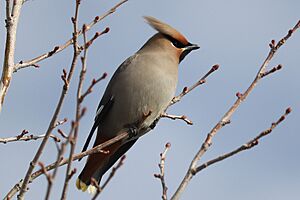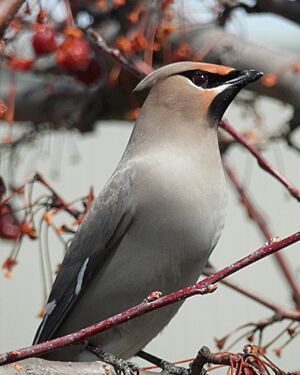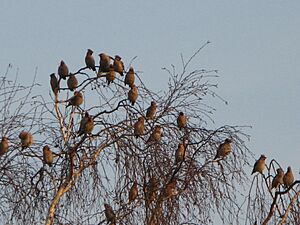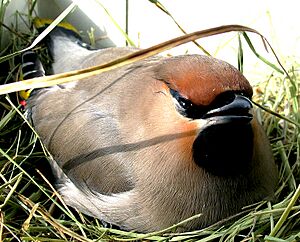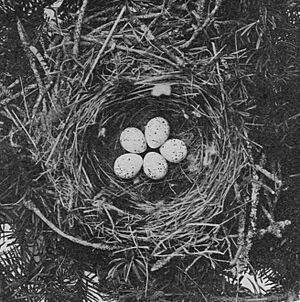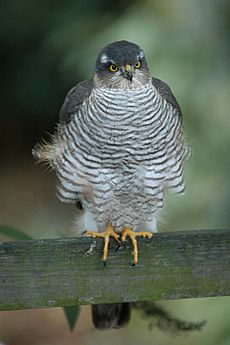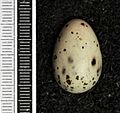Bohemian waxwing facts for kids
Quick facts for kids Bohemian waxwing |
|
|---|---|
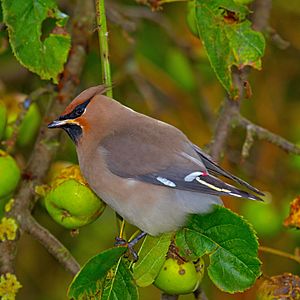 |
|
| Conservation status | |
| Scientific classification | |
| Genus: |
Bombycilla
|
| Species: |
garrulus
|
 |
|
| Range of B. garrulus Breeding Resident Non-breeding
(All ranges are approximate, and many birds occur outside the main wintering range even in non-irruption years.) |
|
| Synonyms | |
|
|
The Bohemian waxwing (Bombycilla garrulus) is a bird about the size of a common starling. It lives and breeds in the northern forests of Europe, Asia, and North America. This bird has mostly buff-grey feathers, black markings on its face, and a cool pointed crest on its head.
Its wings have patterns of white and bright yellow. Some wing feathers have red tips that look like drops of sealing wax. This is how these birds got their name! There are three types (subspecies) of Bohemian waxwings, but they look very similar. Female birds look a lot like males, but young birds are not as brightly colored and have fewer or no waxy wingtips.
Bohemian waxwings build a cup-shaped nest in a tree or bush, often near the trunk. The female sits on 3 to 7 eggs for about 13 to 14 days until they hatch. Baby waxwings are born without feathers and are fed by both parents. At first, they eat mostly insects, but then switch to fruit. They leave the nest when they are about 14 to 16 days old.
Many Bohemian waxwings fly south for the winter. In some years, huge numbers of them travel far beyond their usual winter homes. This happens when they are searching for fruit, which is most of what they eat. These birds can be quite friendly in winter. They might even come into towns and gardens looking for food, especially rowan berries.
Bohemian waxwings can eat fruit that has started to ferment. This means the fruit has a little bit of natural alcohol in it. The birds can handle this well, but sometimes they might get a little wobbly. They are very common and live in a huge area. Because of this, they are considered a species of "least concern" by conservation groups.
Contents
About the Bohemian Waxwing
What is a Waxwing?
Waxwings are a family of birds called Bombycillidae. They are stocky birds with short tails, soft feathers, and a crest on their heads. Their wings and tails have special patterns. There are three types of waxwings: the Bohemian, the cedar, and the Japanese waxwing.
Scientists have studied their DNA to learn how they are related. The Japanese and Bohemian waxwings seem to be the closest relatives. They are both fairly large and have grey undersides. Even though only the cedar and Bohemian waxwings usually have red tips on their wing feathers, the Japanese waxwing sometimes has them too. This suggests that red tips might have been a feature of all waxwings long ago.
Naming the Bohemian Waxwing
The Bohemian waxwing was first described by a scientist named Carl Linnaeus in 1758. He called it Lanius Garrulus. Later, in 1808, another scientist moved the waxwings into their own group, Bombycilla.
The name Bombycilla comes from Greek and Latin words meaning "silk" and "tail." This describes the bird's very soft, silky feathers. The name garrulus is Latin for "talkative." This name was given because people thought the bird looked a bit like the Eurasian jay, which is known for being noisy.
The English name "waxwing" refers to the bright red tips on its wing feathers. These tips look like drops of sealing wax. The word "Bohemian" might refer to the Romani people, hinting at how these birds wander around. Or it could refer to the region of Bohemia.
There are three slightly different types of Bohemian waxwings:
- B. g. garrulus: This type lives in northern Europe, from Norway to the Ural Mountains.
- B. g. centralasiae: This type lives across northern Asia, east of the Urals.
- B. g. pallidiceps: This type lives in northwestern North America.
These differences are very small, so some scientists think they are all just one type of bird.
What Does a Bohemian Waxwing Look Like?
The Bohemian waxwing is about 19 to 23 centimeters (7.5 to 9 inches) long. Its wingspan is about 32 to 35.5 centimeters (12.5 to 14 inches). On average, it weighs about 55 grams (1.9 ounces). It has a short tail and is mostly brownish-grey. A noticeable crest sits on its head.
Males have a black mask around their eyes and a black throat. There's a white stripe behind the beak and a white curve under the eye. Their lower belly is a rich chestnut color. The tail has a bright yellow band at the end with a wide black border above it.
The wings are very special. The flight feathers are black, and they have markings that create a yellow stripe and white "fishhooks" when the wing is closed. The adult bird's secondary feathers have long red tips that look like sealing wax. Its eyes are dark brown, its beak is mostly black, and its legs are dark grey or black.
When flying in a large group, waxwings look a bit like common starlings because of their long wings and short tails. They fly fast and straight. They can climb easily through bushes and trees but mostly shuffle when on the ground.
Female Bohemian waxwings look very much like males. However, their yellow tail band is narrower, and their black throat patch is less clear. Young birds are duller than adults. They have whiter undersides, only a few red wing tips, and no black on their throat.
How Do They Sound?
The Bohemian waxwing's call is a high, trilling sound, like "sirrrr." It's not as wobbly as the cedar waxwing's call and is longer and lower-pitched than the Japanese waxwing's call. Baby birds use a quieter version of this call to get their parents' attention. When a flock of waxwings takes off or lands, their wings make a distinct rattling sound. You can hear this sound from about 30 meters (100 feet) away!
Where Do Bohemian Waxwings Live?
Bohemian waxwings live all around the northern parts of the world, including Europe, Asia, and North America. They breed in northern areas, usually where the weather is cool and there are lots of conifer trees.
Migration and Winter Homes
These waxwings are migratory birds. This means they leave their breeding areas and fly south for the winter. Migration starts in September in the far north and a bit later farther south. Birds from Europe usually spend winter in places like eastern Britain, parts of Europe, Ukraine, Kazakhstan, and Japan. North American birds often fly southeast, with many spending winter in Canada and some in the northern United States.
Birds usually do not go back to the same winter spots each year. One bird that spent winter in Ukraine was found 6,000 kilometers (3,700 miles) east in Siberia the next year!
Irruptions: Traveling Far for Food
In some years, huge numbers of waxwings fly much farther south than usual. This is called an "irruption." It happens because the amount of fruit they eat in winter changes from year to year. If there isn't enough fruit in their usual winter areas, especially after a year with lots of fruit, the flocks will keep moving south until they find enough food. They will stay until the food runs out and then move on again.
One of the biggest irruptions in Europe happened in the winter of 2004–2005. More than half a million waxwings were seen in Germany alone! This happened after a very warm and dry breeding season.
Habitats
During the breeding season, Bohemian waxwings live in mature conifer forests, often with spruce trees. They also like open, wet areas like lakes and swamps where they can find insects. Outside the breeding season, they live in many different places as long as there are fruits like rowan berries. You might find them near roads, in parks, gardens, or along the edges of woodlands. They are not very afraid of people during this time. In winter, waxwings sleep together in large groups in thick trees or hedges.
Bohemian Waxwing Behavior
Breeding and Nests
Bohemian waxwings start returning from their winter homes in February or March. However, birds that breed farther north don't reach their nesting areas until April or early May. These birds usually have one mate and build nests mainly from mid-June to July.
Waxwings are not very territorial. Even though they usually nest alone, several pairs might build nests close together if there are many good spots. Males might try to keep other males away from their mates. Females might argue over nesting spots. When they are aggressive, they smooth down their feathers and crest, show their black throat, and open their beak.
The male's courtship display is almost the opposite. He stands tall, raises his crest feathers, and turns his head away from the female. The male might also offer a small gift, often food, to his partner by placing it in her open beak. Older males, who have more red tips on their wings, are often chosen by females.
Both the male and female build the nest. It's a cup made of thin twigs lined with softer materials like fine grass, moss, fur, or lichen. The nest is usually built 1.3 to 15 meters (4 to 49 feet) above the ground in a pine tree or bush, often close to the tree trunk.
The eggs are a shiny pale blue with black and grey spots. A female usually lays 3 to 7 eggs, but five or six is most common. Each egg is about 24 x 18 millimeters (0.9 x 0.7 inches) and weighs about 3.8 grams (0.13 ounces). The female sits on the eggs for 13 to 14 days. Her mate brings her regurgitated berries, and she rarely leaves the nest.
Baby waxwings are born without feathers and have bright red mouths. Both parents feed them, but the male brings most of the food, which is mainly insects, in the first few days. After that, the young birds are fed mostly fruit. The chicks leave the nest about 14 to 16 days after hatching. The adults continue to feed them for about two weeks after they leave the nest.
Bohemian waxwings usually have one group of babies each year. The oldest recorded waxwing lived for 5 years and 10 months in North America, and over 13 years and 6 months in Europe.
What Do They Eat?
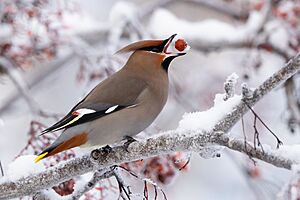
Waxwings mainly eat fruit, but they also eat insects during the breeding season. Mosquitoes and midges are common insect prey, but they also eat many other insects and some spiders. They catch insects mostly by flying out from a perch, but sometimes they pick them off plants. Fruit is usually picked from trees, sometimes from the ground, and is swallowed whole.
In summer, they eat berries from plants like Vaccinium (blueberries, cranberries) and Rubus (raspberries, blackberries), and Canada buffaloberry. Outside the breeding season, they mostly eat cotoneaster, juniper, haws, rose hips, and apples. Rowan berries are a favorite food and are eaten whenever they can find them.
Waxwings can eat a huge number of berries, sometimes several hundred a day! This can be more than double their own weight. One bird was seen eating between 600 and 1,000 cotoneaster berries in six hours. Waxwings travel long distances while feeding, which helps spread the seeds of the fruits they eat. They often feed in large groups, sometimes hundreds of birds. This allows them to overwhelm other birds, like mistle thrushes, that try to protect their fruit trees.
Fruit is full of sugar but doesn't have many other nutrients. So, waxwings have to eat a lot of it. Bohemian waxwings have a large liver that helps them turn sugar into energy. They can process the natural alcohol that forms in fermenting sugary fruits better than humans can. However, they can still get a bit dizzy sometimes. Waxwings often drink water or eat snow in winter. This is because the sugar in their fruit diet can make them thirsty. In summer, the fruits are juicier, so water is less of a problem.
Long ago, people in some places thought that when waxwings arrived, it meant sickness like cholera was coming. They even called them "plague birds." But people also thought the juniper berries the birds ate could protect them. So, people would eat the fruit and burn juniper branches to clean their houses.
Dangers and Health
Predators
Bohemian waxwings are hunted by birds of prey. These include rough-legged buzzards, Eurasian sparrowhawks, prairie falcons, and great grey shrikes. Small falcons called Merlins attack waxwing flocks in winter, even in cities. When a Bohemian waxwing feels in danger, it will "freeze" with its beak and neck pointing upwards. If that doesn't work, they will fly away, making loud calls.
Parasites
Bohemian waxwings can have tiny creatures called mites living on them. They can also have blood parasites and parasitic worms. However, they usually don't have many worms.
Conservation Status
There are more than three million Bohemian waxwings in the world. Their breeding range covers about 12.8 million square kilometers (4.9 million square miles). Even though the number of these birds seems to be going down a little, the decrease is not fast or large enough to be a big worry for conservation. Because there are so many of them and they live in such a huge area, the International Union for Conservation of Nature classifies this waxwing as being of "least concern." The forests where they breed are far north of most human populations. Also, these birds can live in areas that have been changed by humans. So, there are no serious long-term threats to this species.
Images for kids


